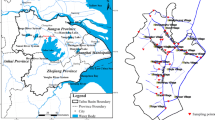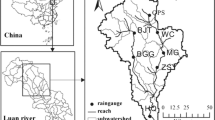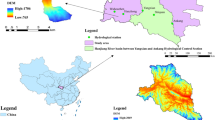Abstract
Nonpoint source (NPS) pollution is considered as the main reason for water quality deterioration; thus, to quantify the NPS loads reliably is the key to implement watershed management practices. In this study, water quality and NPS loads from a watershed with limited data availability were studied in a mountainous area in China. Instantaneous water discharge was measured through the velocity-area method, and samples were taken for water quality analysis in both flood and nonflood days in 2010. The streamflow simulated by Hydrological Simulation Program-Fortran (HSPF) from 1995 to 2013 and a regression model were used to estimate total annual loads of various water quality parameters. The concentrations of total phosphorus (TP) and total nitrogen (TN) were much higher during the flood seasons, but the concentrations of ammonia nitrogen (NH3-N) and nitrate nitrogen (NO3-N) were lower during the flood seasons. Nevertheless, only TP concentration was positively correlated with the flow rate. The fluctuation of annual load from this watershed was significant. Statistical results indicated the significant contribution of pollutant fluxes during flood seasons to annual fluxes. The loads of TP, TN, NH3-N, and NO3-N in the flood seasons were accounted for 58–85, 60–82, 63–88, 64–81 % of the total annual loads, respectively. This study presented a new method for estimation of the water and NPS loads in the watershed with limited data availability, which simplified data collection to watershed model and overcame the scale problem of field experiment method.




Similar content being viewed by others
References
APHA (2005) Standards methods for the examination of water and wastewater, 1st edn. American Public Health Association, Washington DC
Arnold JG, Srinivasan R, Muttiah RS, Williams JR (1998) Large area hydrologic modeling and assessment part I: model development 1. JAWRA J Am Water Resour As 34(1):73–89
Bicknell BR, Imhoff JC, Kittle JJL, Jobes THD, JrAS (2011) Hydrological Simulation Program – Fortran (HSPF): user’s manual for release 12. U.S. Environmental Protection Agency, Athens
Boomer K, Li X, Weller D (2011) Applying multiple models to inform watershed management and land use planning in a coastal community. The NOAA/UNH Cooperative Institute for Coastal and Estuarine Environmental Technology (CICEET). Retrieved from http://ciceet.unh.edu/news/releases/fall11_reports/pdf/boomer_LU07_fr_fall_2011.pdf. Accessed 7 April 2015
Borah DK, Bera M (2003) Watershed-scale hydrologic and nonpoint-source pollution models: review of mathematical bases. T ASAB 46(6):1553–1566
Broad ST, Corkrey R (2010) Estimating annual generation rates of total P and total N for different land uses in Tasmania, Australia. J Environ Manage 92(6):1609–1617
Chang CH, Wen CG, Huang CH, Chang SP, Lee CS (2008) Nonpoint source pollution loading from an undistributed tropic forest area. Environ Monit Assess 146(1–3):113–126
Chen J, Lu J (2014) Establishment of reference conditions for nutrients in an intensive agricultural watershed, Eastern China. Environ Sci Pollut R 21(4):2496–2505
Chen L, Liu RM, Huang Q, Chen YX, Gao SH, Sun CC (2012) An integrated simulation-monitoring framework for nitrogen assessment: a case study in the Baixi watershed, China. Procedia Environ Sci 13:1076–1090
Correll DL, Jordan TE, Weller DE (1999) Precipitation effects on sediment and associated nutrient discharges from Rhode River watersheds. J Environ Qual 28(6):1897–1907
Deasy C, Brazier RE, Heathwaite AL, Hodgkinson R (2009) Pathways of runoff and sediment transfer in small agricultural catchments. Hydrol Proc 23(9):1349–1358
Du X, Li X, Hao S, Wang H, She X (2014a) Contrasting patterns of nutrient dynamics during different storm events in a semi-arid catchment of northern China [J]. Water Sci Technol 69(12):2533–2540
Du X, Li X, Zhang W, Wang H (2014b) Variations in source apportionments of nutrient load among seasons and hydrological years in a semi-arid watershed: GWLF model results. Environ Sci Pollut R 21(10):6506–6515
U.S. Environmental Protection Agency (2000) EPA BASINS Technical Note 6: estimating hydrology and hydraulic parameters for HSPF. EPA-823 R00-012. Retrieved from http://water.epa.gov/scitech/datait/models/basins/index.cfm. Accessed 7 April 2015.
Evans BM, Sheeder SA, Lehning DW (2004) A spatial technique for estimating streambank erosion based on watershed characteristics. J Spati Hydrol 3(1):1–13
Johnson MS, Coon WF, Mehta VK, Steenhuis TS, Brooks ES, Boll J (2003) Application of two hydrologic models with different runoff mechanisms to a hillslope dominated watershed in the northeastern US: a comparison of HSPF and SMR. J Hydrol 284(1–4):57–76
Kawara O, Hirayma K, Kunimatsu T (1996) A study on pollutant loads from the forest and rice paddy fields. Water Sci Technol 33(4):159–165
Lai YC, Yang CP, Hsieh CY, Wu CY, Kao CM (2011) Evaluation of non-point source pollution and river water quality using a multimedia two-model system. J Hydrol 409(3):583–595
Lee CS, Chang CH, Wen CG, Chang SP (2010) Comprehensive nonpoint source pollution models for a free-range chicken farm in a rural watershed in Taiwan. Agr Ecosyst Environ 139(1):23–32
Li X, Weller DE, Jordan TE (2010) Watershed model calibration using multi-objective optimization and multi-site averaging. J Hydrol 380(3):277–288
Liang T, Wang S, Cao H, Zhang C, Li H et al (2008) Estimation of ammonia nitrogen load from nonpoint sources in the Xitiao River catchment, China. J Environ Sci 20(10):1195–1201
Ongley ED, Xiaolan Z, Tao Y (2010) Current status of agricultural and rural non-point source pollution assessment in China. Environ Pollut 158(5):1159–1168
Petrucci G, Gromaire M, Shorshani MF (2014) Nonpoint source pollution of urban stormwater runoff: a methodology for source analysis. Environ Sci Pollut R 21(17):10225–10242
Pratt B, Chang H (2012) Effects of land cover, topography, and built structure on seasonal water quality at multiple spatial scales. J Hazard Mater 209:48–58
Qian Y, Migliaccio KW, Wan Y, Li Y (2007) Trend analysis of nutrient concentrations and loads in selected canals of the Southern Indian River Lagoon, Florida. Water, Air, Soil Pollut 186(1–4):195–208
Roberts AD, Prince SD (2010) Effects of urban and non-urban land cover on nitrogen and phosphorus runoff to Chesapeake Bay. Ecol Indic 10(2):459–474
Roberts AD, Prince SD, Jantz CA, Goetz SJ (2009) Effects of projected future urban land cover on nitrogen and phosphorus runoff to Chesapeake Bay. Ecol Eng 35(12):1758–1772
Shen Z, Hong Q, Yu H, Liu R (2008) Parameter uncertainty analysis of the non-point source pollution in the Daning River watershed of the Three Gorges Reservoir Region, China. Sci Total Environ 405(1):195–205
Shen Z, Liao Q, Hong Q, Gong Y (2012) An overview of research on agricultural non-point source pollution modelling in China. Sep Purif Technol 84:104–111
Shen Z, Chen L, Hong Q, Xie H, Qiu J, Liu R (2013) Vertical variation of nonpoint source pollutants in the Three Gorges Reservoir Region. Plos One 8(8):e71194
Shrestha S, Kazama F, Newham LTH (2008) A framework for estimating pollutant export coefficients from long-term in-stream water quality monitoring data. Environ Model Software 23(2):182–194
Stuart GW, Edwards PJ (2006) Concepts about forests and water. North J Appl For 23(1):11–19
Wang H, Li X, Xie Y (2011) Hydrochemical evaluation of surface water quality and pollution source apportionment in the Luan River basin, China. Water Sci Technol 64(10):2119–2125
Wang H, Li X, Li W, Du X (2014a) The impact of digital elevation model and land use spatial information on hydrologic simulation program-FORTRAN-predicted stream flow and sediment uncertainty. J Hydroinform 16(5):989–1003
Wang Y, Li Y, Liu X (2014b) Relating land use patterns to stream nutrient levels in red soil agricultural catchments in subtropical central China. Environ Sci Pollut R 21(17):10481–10492
Wang H, Wu Z, Hu C (2015) A comprehensive study of the effect of input data on hydrology and non-point source pollution modeling. Water Resour Manag 29(5):1505–1521
Xie Y, Li X, Wang H, Li W (2013) Spatio-temporal variation analysis of hydrochemical characteristics in the Luanhe River Basin, China. Water Sci Technol 67(6):1332–1338.
Yuan D, Lin B, Falconer RA, Tao J (2007) Development of an integrated model for assessing the impact of diffuse and point source pollution on coastal waters. Environ Model Software 22(6):871–879
Zhang J, Shen T, Liu M, Wan Y, Liu J, Li J (2011) Research on non-point source pollution spatial distribution of Qingdao based on L-THIA model. Math Comput Model 54(3):1151–1159
Acknowledgments
Funding was supported by Open Laboratory of Water Conservancy and Science of Key Disciplines in Henan Province, the National Natural Science Foundation of China (No. 51079131, and No.51379191), and the CAS/SAFEA International Partnership Program for Creative Research Teams of ‘Ecosystem Processes and Services’ (Grant No.KZCX2-YW-T13). The authors would like to thank the Chengde Branch of Hebei Provincial Survey Bureau of Hydrology and Water Resources for providing hydrological data. Finally, the authors would like to express their sincere gratitude to the anonymous reviewers for their constructive comments and the Editor of the journal. Their detailed suggestions have resulted in an improved manuscript.
Author information
Authors and Affiliations
Corresponding author
Additional information
Responsible editor: Michael Matthies
Rights and permissions
About this article
Cite this article
Huiliang, W., Zening, W., Caihong, H. et al. Water and nonpoint source pollution estimation in the watershed with limited data availability based on hydrological simulation and regression model. Environ Sci Pollut Res 22, 14095–14103 (2015). https://doi.org/10.1007/s11356-015-4450-6
Received:
Accepted:
Published:
Issue Date:
DOI: https://doi.org/10.1007/s11356-015-4450-6




